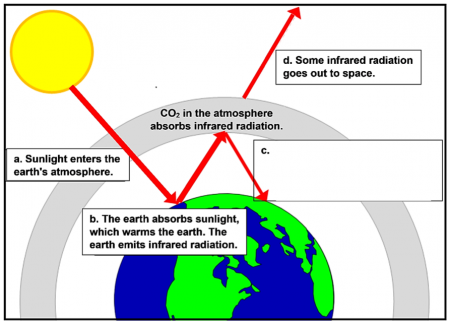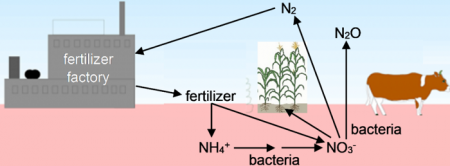Serendip is an independent site partnering with faculty at multiple colleges and universities around the world. Happy exploring!
Teaching Resources for Climate Change
Classroom Activities

Introduction to Global Warming
To begin this minds-on analysis and discussion activity, students learn about the correlated increases in global temperatures and CO2 concentrations in the atmosphere. Next, students evaluate an example that illustrates that correlation does not necessarily imply causation.
Then, students analyze several types of evidence to test the hypothesis that increased CO2 in the atmosphere has been a major cause of the increase in global temperatures. This activity concludes with a very brief discussion of how global warming has contributed to harmful effects (e.g., increased flooding) and possible student actions to reduce these harmful effects.

Food and Climate Change – How can we feed a growing world population without increasing global warming?
In this analysis and discussion activity, students learn how food production results in the release of three greenhouse gases – carbon dioxide (CO2), nitrous oxide (N2O), and methane (CH4). Students analyze carbon and nitrogen cycles to understand how agriculture results in increased CO2 and N2O in the atmosphere.
Students interpret data concerning the very different amounts of greenhouse gases released during the production of various types of food; they apply concepts related to trophic pyramids and they learn about CH4 release by ruminants.
Finally, students propose, research, and evaluate strategies to reduce the amount of greenhouse gases that will be released during future production of food for the world’s growing population.
Global Warming News from the New York Times
- It’s Not Just Poor Rains Causing Drought. The Atmosphere Is ‘Thirstier.’
- El aumento del calor hace de la peregrinación a La Meca una prueba de resistencia
- Amid Rising Heat, Hajj Becomes Test of Endurance for Pilgrims and Saudi Arabia
- Trump’s Pick to Run the Forest Service Has a History With the Agency
- The White House Gutted Science Funding. Now It Wants to ‘Correct’ Research.
- Michael Boren Built an Airstrip on Protected Land. Now He Might Lead the Forest Service.
- Trump Administration to Open Alaska Wilderness to Drilling and Mining
Climate Change News from The Guardian
- That sinking feeling: Australia’s Limestone Coast is drying up
- James Cleverly takes on Kemi Badenoch over decision to ditch net zero targets
- There are huge floods and/or droughts all over! And insurance is wildly expensive (if you can even get it) | First Dog on the Moon
- A moment that changed me: I saw my first wild water bear – and snapped out of my despair at the world
- Fire stations in England ‘falling apart’ amid £1bn funding cut, chiefs say
- I received a 30-month jail sentence for nonviolent resistance. Why so harsh? Because protest works | Indigo Rumbelow
- ‘Half the tree of life’: ecologists’ horror as nature reserves are emptied of insects
Climate Change Posts from Nature
- Don’t overlook the mental-health costs of California’s wildfires
- Atmospheric circulation to constrain subtropical precipitation projections
- Drivers of marine heatwaves in coral bleaching regions of the Red Sea
- Warming triggers snowfall fraction loss Thresholds in High-Mountain Asia
- Polar bears and expanding sea ice in the Mid Holocene Aleutian Islands, Alaska
- More autumn tropical cyclone genesis in the South China Sea during El Niño to La Niña transition
- Optimizing afforestation pathways through economic cost mitigates China’s financial challenge of carbon neutrality
Climate Solutions from Union of Concerned Scientists
- The Crumbling of Bedrock Environmental Policy: We Need to Protect NEPA
- Trump Administration Slashes NOAA, FEMA, Making 2025 Hurricane Season More Dangerous
- ExxonMobil’s 2025 Climate Report Fails Scientific Review—Again
- Wildfires Are Getting Worse. Trump’s Science Cuts Could Threaten Our Response.
- 12,000 Reasons Why the Trump Administration Must Be Stopped from Dismantling FEMA
- Seven Questions for EPA Administrator Lee Zeldin as He Testifies Before Congress
- Trump Administration Attempts Burying Climate Change Evidence to Further Fossil Fuel Agenda
Resources for Teaching and Learning about Climate Change
This annotated list includes resources that can help your students to develop a scientifically accurate understanding of the causes and consequences of global warming and climate change. This list also includes resources for learning about how to reduce greenhouse gases and how to cope with the harmful effects of climate change. When learning about climate change, it is important for students to engage with proposals to mitigate and adapt to climate change, so they can feel energized, instead of powerless. Given the nature of the topic, the approach is interdisciplinary. These resources are appropriate for middle school, high school and/or college students.
